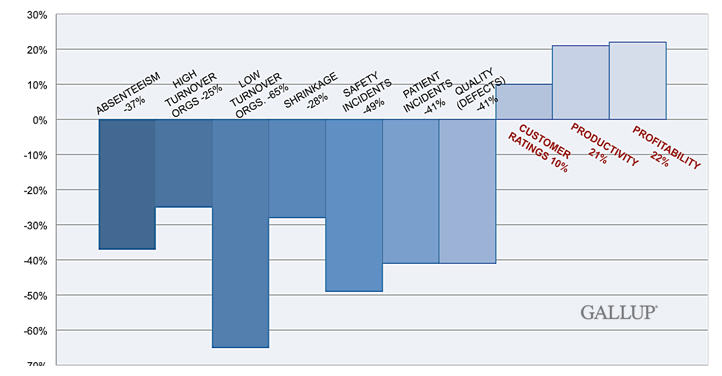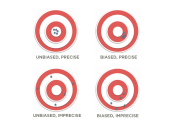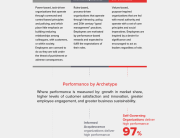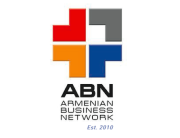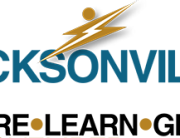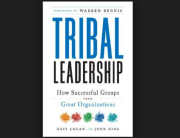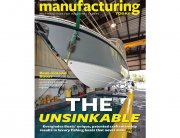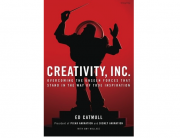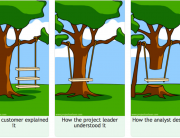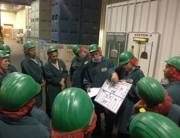As featured in the June 2014 issue of Effective Flow Magazine:
It’s the elusive goal behind every Continuous Improvement initiative: Every organization wants to become a high performing workplace. But what does this entail? How does one go about achieving it? How long does it take? I’ve spent my career answering these questions.
I have read countless tomes on the subject of business success and how to achieve it, benefited from the mentorship of thought leaders and my experience has put me in the midst of a variety of companies from startups to Fortune 500 powerhouses. What I’ve found is that regardless of the size organization or industry, all of the high performing workplaces I’ve come across or helped to develop share the same fundamental characteristics:
1) The company’s distinctive and authentic purpose is well known, abided by and demonstrated.
2) Employee engagement and cultivating a healthy company culture is a priority.
3) There is a clear understanding of:
– the way the company creates and delivers value
– who it is delivered to and
– how and when that value is compromised
4) There is alignment around organizational goals.
5) Accountability goes both ways (team to executives and executives to team) and measurement is routine.
Nothing less than a commitment to the thoughtful and thorough execution of ALL FIVE of these elements is required to realize high performing status. Here’s why:
PURPOSE
Just as North represents a fixed point against which the traveler can orient himself and plot his journey, your company’s mission, vision, values and purpose serve as that point of orientation to your organization. It guides your organization’s infrastructure, decision making, shapes your culture, and has the power to attract talent and customers when demonstrated authentically.
Julia Harz, co-founder of EventBrite, one of Inc’s 25 most audacious companies, puts it like this, “Setting a philosophy and being explicit about it is scary,” Hartz says. “You can easily have fears about becoming stagnant or irrelevant. But it’s important to provide a North Star–to provide
an anchor.”
That anchor is the motivating through line of your organization and a key component of its competitive advantage. As Simon Sinek says, “People don’t buy what you do, they buy Why you do it.”
EMPLOYEE ENGAGEMENT / CULTURE
All employees from the C-suite to customer service to the production line want to matter. Whether or not they feel like they do directly correlates to productivity and the culture executive leaders personify and allow to flourish.
Meaningfully engaging your team is not about a suggestion box, employee of the month plaque or gift certificate raffle. It involves regularly taking the pulse of the employee population, asking them about their needs, understanding their grievances and helping them to realize the value in their current and future roles. Most importantly, it requires acting on that insight to improve the working environment, delivery of your products and services, talent capability and meaningfully recognize contributions.
Of all of the elements of a high performing business, this is the one that companies shy away from the most. Why? It’s hard to measure and takes a while to come to fruition. But the upside is HUGE. The chart below is Gallup’s take on the benefits of employee engagement: lower costs and increased value:
The downside is that whether or not you address it, failing to tend to employee engagement is already costing you:
• Gallup estimates that a disengaged employee costs an organization approximately $3,400 for every $10,000 of salary.
• Disengaged employees cost the American economy $450 billion to $550 billion in lost productivity per year.
CREATING AND DELIVERING VALUE
I’ve often walked into clients and asked about their Business Model. What I get are answers about the revenue streams or aspect of their value proposition sometimes about their cost structure. But those are only partial answers.
The creation of your value proposition involves an eco system of partners and employees. This is underpinned by assumptions about your competitive environment and customer needs that through a related set of processes enable the delivery of the value proposition your customers are currently willing to pay for. Key word: currently.
The second the nature of the demand, profile of the customer or any other factor in that eco system changes, you’ve got yourself a potentially outmoded business model and with it, different costs, processes, revenue opportunity and market realities to consider. In short, one change can change everything. When I see friction in an organization it’s often because an element in the model changed, and there was insufficient understanding of the impact implementing that change would have on other aspects of the business. Introducing a new product, engaging a different partner, or delivering via a different channel all requires recalibrating the model.
That said, one of the most significant indicators of your model’s success rests on how well you understand your customers and act on their needs. Which brings me to the need to engage them with some regularity. What problems do they need to solve? What can you do better to help? Engage those that have been most problematic – there is some particularly useful insight about ways to improve your business there.
ORGANIZATIONAL ALIGNMENT
This is a simple one at first glance. If everyone on the team understands the organization’s purpose, is treated like a human being and not a means to an end and how the company’s products and services deliver value then everyone will naturally focus their efforts in the same direction – right?
Not exactly. These goals need to be communicated – and not in a one time memo or mention in a town hall. “Increase fill in the blank by 10%” is too general a statement to have any meaning for most of the organization.
Instead goals need to be broken down into RELEVANT activities for each area of the organization. This way teams across the company can understand their role in driving company success and employees can take pride in their individual contributions.
ACCOUNTABILITY
What I’m talking about here is a change in the leadership – employee relationship. Less closed doors and more transparency. I believe the lack of transparency often has to do with a fear of conflict, which in turn prevents us from engaging each other, holding people accountable and results in low trust, low morale environments.
This means being upfront about the bad news, about change, about the hard choices and about the real numbers. Sure there will be disappointment at times but that’s so much easier to get over than a loss of trust (see employee engagement). If you’re accountable, it will be much less painful to hold others accountable too.
Holding yourself and your team accountable is a lot easier when success is quantifiable. Not to say that it all is, for example, it’s tough to “measure” employee satisfaction. But the implications of it (lower attrition, lower defects, less sick days, expanded customer relationships) can be. It all depends on the lens you’re using to determine success.
ARE WE THERE YET?
Even when there is a tangible effort to creating the kind of environment where high performance is possible, there is always the question of timing. Despite the fact that it has taken months if not years to get to the current state, recovery is for some reason expected to be quick and easy. Note: These are not 3 – 6 month initiatives. Moreover these efforts do not run on autopilot and they need full time champions – not lip service.
To save you the suspense, I’ll tell you to expect it to take at least a year to put these measures in place and begin to govern your organization in this manner. It will take 3 – 6 months to evaluate and hone in on your purpose, business model and strategic plan. A couple more months to explore employee and customer perception. And then the real work of improving that perception via the act of changing your current state begins.
It will be challenging, but I guarantee that if you stay the course, you’ll start to see results within the year. But better than realizing short-term improvements to the bottom line, you’ll be investing in the means by which to sustain these performance gains – in effect releasing you from the drudgery of cost cutting to instead focus on creating real competitive advantage.


